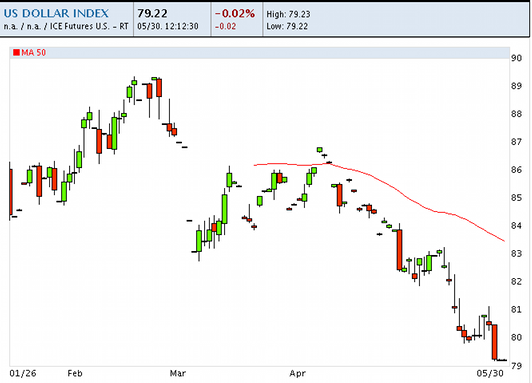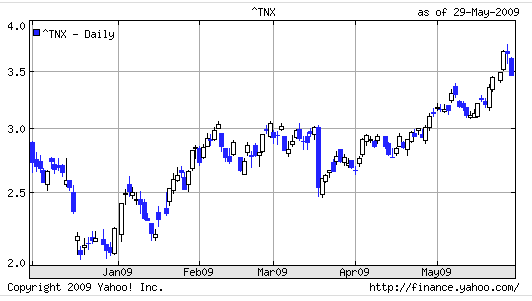« May 28, 2009 | Main | June 2, 2009 »
Sunday, May 31, 2009
Gnome-o-gram: Endgame?
Take a look at the following charts, each covering recent months (you can click the images to obtain up-to-date charts from the original providers). The first chart shows the U.S. Dollar index, which measures the relative performance of the dollar against a basket of currencies including the Euro, Yen, British Pound, Canadian Dollar, Swiss Franc, and Swedish Kronor. Ignore the detail and just take in the “big picture”, which is that since the Obama administration took office in January the U.S. dollar has been sliding, with an accelerating plunge in recent days (this analysis was written on 2009-05-31). The next chart shows the interest rate on the bellwether 10 year United States Treasury Note for the last six months.
Ignore the detail and just take in the “big picture”, which is that since the Obama administration took office in January the U.S. dollar has been sliding, with an accelerating plunge in recent days (this analysis was written on 2009-05-31). The next chart shows the interest rate on the bellwether 10 year United States Treasury Note for the last six months.
 Now this chart could almost be the mirror image of the first one: ever since January 2009 Treasury Note interest rates have been rising steadily, at an increasing rate recently. But usually, interest rates and currency strength move together; when a currency provides higher yield, investors sell other currencies to move their funds into it, hence bidding it up against lower yielding currencies. This is why central banks are forced to raise interest rates when their currencies begin to weaken.
But here we have the dollar simultaneously swooning in value at the same time interest rates are rising dramatically. What's going on here? Well, this kind of divergence is precisely what you see when investors are concerned about the stability of the currency and the safety of the principal they invest in it. As the perceived risk of not getting your money back, either directly due to a full or partial default, or stealthily by inflation reducing the value of the money you're repaid when the bond matures, investors will demand a higher rate of return to compensate them for the risk they're running, and this rising rate will not increase the value of the currency, as risk averse investors move their money to other currencies which are perceived to be safer, even though they pay a lower rate of interest.
In short, what we're seeing is the pattern you'd expect as a currency confidence crunch begins to take hold. Nobody is more attuned to the risk of inflation or default than investors in long term bonds, and buyers of Treasury paper are the most risk averse of all. So when these folks start to pull back, as appears to be happening, it's not a good sign for a government whose commitments require it to sell debt in amounts unprecedented in human history.
If this pattern continues, the risk of a destructive positive feedback loop increases in probability. Here's how it works. A government running enormous deficits and carrying a huge debt load spends correspondingly large sums on debt service (US$451 billion in the
2008 fiscal year). Now since the government is running deficits, the only way to repay holders of maturing bonds is to roll them over, selling new bonds. But the rollover occurs at the prevailing interest rate at the time, and if that rate has, say, doubled in the meanwhile, then the government's borrowing cost will be twice that for the new bond. This further increases the deficit, and with it the perceived risk, pushing interest rates still higher, and around and around we go. Eventually, the situation deteriorates to the point the Treasury can no longer find investors willing to buy its paper at all, or only at rates so high they cause the economy to collapse (since interest rates of all kinds rise when Treasury rates increase)—game over.
A government caught in this cycle may attempt to break it by instructing its central bank to step in and buy the newly issued debt, which amounts to printing money (indeed, the Federal Reserve has been doing precisely this in recent months). But as soon as investors see this happening, they expect inflation to set in once all of the newly-created money works its way through the python of the economy, and they start to bail out of the currency, driving down its value against others. But once a currency starts to slide, bond buyers will demand higher interest rates to compensate them for the expected depreciation of the currency. And so you have a falling currency, rising interest rates, difficulty financing ever-growing deficits which accelerate as debt service costs spike, and the central bank monetising the debt by creating money, which drives interest rates higher, crushing the economy, which causes tax receipts to fall, which further increases the deficits. How do you get out of this? Some countries never do.
The U.S. isn't there yet, but keep an eye on these two charts as the massive borrowing expected in the coming months occurs. If they continue to diverge and accelerate, it may be an indication that the endgame phase is underway. And remember that once a currency confidence crisis reaches the feedback loop stage, things can deteriorate with breathtaking speed. And note that every increase in the interest rate causes a slowdown in the economy. In particular, the “reset” rates of adjustable rate mortgages rise, which makes those holding them more likely to default, and less able to refinance as a new fixed rate mortgage will be at the new higher rate.
Now this chart could almost be the mirror image of the first one: ever since January 2009 Treasury Note interest rates have been rising steadily, at an increasing rate recently. But usually, interest rates and currency strength move together; when a currency provides higher yield, investors sell other currencies to move their funds into it, hence bidding it up against lower yielding currencies. This is why central banks are forced to raise interest rates when their currencies begin to weaken.
But here we have the dollar simultaneously swooning in value at the same time interest rates are rising dramatically. What's going on here? Well, this kind of divergence is precisely what you see when investors are concerned about the stability of the currency and the safety of the principal they invest in it. As the perceived risk of not getting your money back, either directly due to a full or partial default, or stealthily by inflation reducing the value of the money you're repaid when the bond matures, investors will demand a higher rate of return to compensate them for the risk they're running, and this rising rate will not increase the value of the currency, as risk averse investors move their money to other currencies which are perceived to be safer, even though they pay a lower rate of interest.
In short, what we're seeing is the pattern you'd expect as a currency confidence crunch begins to take hold. Nobody is more attuned to the risk of inflation or default than investors in long term bonds, and buyers of Treasury paper are the most risk averse of all. So when these folks start to pull back, as appears to be happening, it's not a good sign for a government whose commitments require it to sell debt in amounts unprecedented in human history.
If this pattern continues, the risk of a destructive positive feedback loop increases in probability. Here's how it works. A government running enormous deficits and carrying a huge debt load spends correspondingly large sums on debt service (US$451 billion in the
2008 fiscal year). Now since the government is running deficits, the only way to repay holders of maturing bonds is to roll them over, selling new bonds. But the rollover occurs at the prevailing interest rate at the time, and if that rate has, say, doubled in the meanwhile, then the government's borrowing cost will be twice that for the new bond. This further increases the deficit, and with it the perceived risk, pushing interest rates still higher, and around and around we go. Eventually, the situation deteriorates to the point the Treasury can no longer find investors willing to buy its paper at all, or only at rates so high they cause the economy to collapse (since interest rates of all kinds rise when Treasury rates increase)—game over.
A government caught in this cycle may attempt to break it by instructing its central bank to step in and buy the newly issued debt, which amounts to printing money (indeed, the Federal Reserve has been doing precisely this in recent months). But as soon as investors see this happening, they expect inflation to set in once all of the newly-created money works its way through the python of the economy, and they start to bail out of the currency, driving down its value against others. But once a currency starts to slide, bond buyers will demand higher interest rates to compensate them for the expected depreciation of the currency. And so you have a falling currency, rising interest rates, difficulty financing ever-growing deficits which accelerate as debt service costs spike, and the central bank monetising the debt by creating money, which drives interest rates higher, crushing the economy, which causes tax receipts to fall, which further increases the deficits. How do you get out of this? Some countries never do.
The U.S. isn't there yet, but keep an eye on these two charts as the massive borrowing expected in the coming months occurs. If they continue to diverge and accelerate, it may be an indication that the endgame phase is underway. And remember that once a currency confidence crisis reaches the feedback loop stage, things can deteriorate with breathtaking speed. And note that every increase in the interest rate causes a slowdown in the economy. In particular, the “reset” rates of adjustable rate mortgages rise, which makes those holding them more likely to default, and less able to refinance as a new fixed rate mortgage will be at the new higher rate.